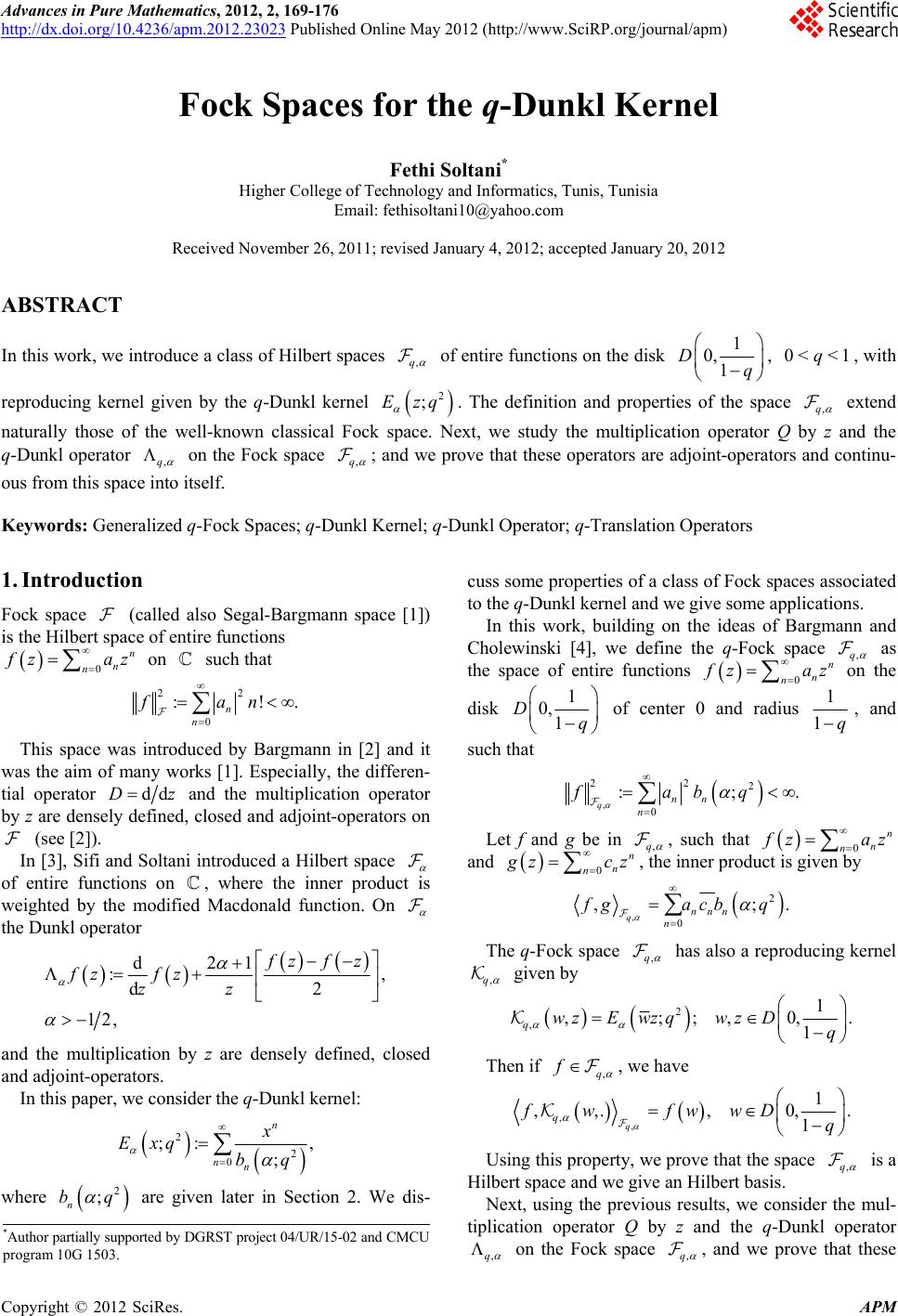 Advances in Pure Mathematics, 2012, 2, 169-176 http://dx.doi.org/10.4236/apm.2012.23023 Published Online May 2012 (http://www.SciRP.org/journal/apm) Fock Spaces for the q-Dunkl Kernel Fethi Soltani* Higher College of Technology and Informati cs, Tunis, Tunisia Email: fethisoltani10@yahoo.com Received November 26, 2011; revised January 4, 2012; accepted January 20, 2012 ABSTRACT In this work, we introduce a class of Hilbert spaces ,q of entire function s on the disk 1 0,D 0< <1q 1q, , with reproducing kernel given by the q-Dunkl kernel 2 ;Ezq ,q . The definition and properties of the space ,q extend naturally those of the well-known classical Fock space. Next, we study the multiplication operator Q by z and the q-Dunkl operator on the Fock space ,q ; and we prove that these operators are adjoint-operators and continu- ous from this space into itself. Keywords: Generalized q-Fock Spaces; q-D un kl Kernel; q-Dunkl Operator; q-Translation Operators 1. Introduction Fock space (called also Segal-Bargmann space [1]) is the Hilbert space of entire functions 0 n n n zaz on such that 22 0 :!. n fan n This space was introduced by Bargmann in [2] and it was the aim of many works [1]. Especially, the differen- tial operator ddDz and the multiplication operator by z are densely defined, closed and adjoint-operators on (see [2]). In [3], Sifi and Soltani introduced a Hilbert space of entire functions on , where the inner product is weighted by the modified Macdonald function. On the Dunkl operator d21 :, d2 12, zfz fz fz zz and the multiplication by z are densely defined, closed and adjoint-operators. In this paper, we consider the q-Du nkl ker n el: 2 2 0, ; n n x bq ;: n Ex q 2 ; n bq where are given later in Section 2. We dis- cuss some properties of a class of Fock spaces associated to the q-Dunkl kernel and we give some appl ications. In this work, building on the ideas of Bargmann and Cholewinski [4], we define the q-Fock space ,q 0 n n n as the space of entire functions zaz on the disk 1 0,1 Dq of center 0 and radius 1 1q , and such that , 22 2 0 :; qnn n fabq . Let f and g be in ,q n , such that 0n n zaz 0 n n n and zcz , the inner product is given by , 2 0 ,;. qnnn n gacbq ,q The q-Fock space ,q has also a reproducing kernel given by 2 ,1 ,;;,0,. 1 qwzE wzqwz Dq ,q f Then if , we have , ,1 ,,., 0,. 1 q q fw fwwDq ,q Using this property, w e prove that the space ,q is a Hilbert space and we give an Hilbert basis. Next, using the previous results, we consider the mul- tiplication operator Q by z and the q-Dunkl operator *Author partially supported by DGRST project 04/UR/15-02 and CMCU on the Fock space ,q , and we prove that these rogram 1 0 G 1 50 3 . C opyright © 2012 SciRes. APM 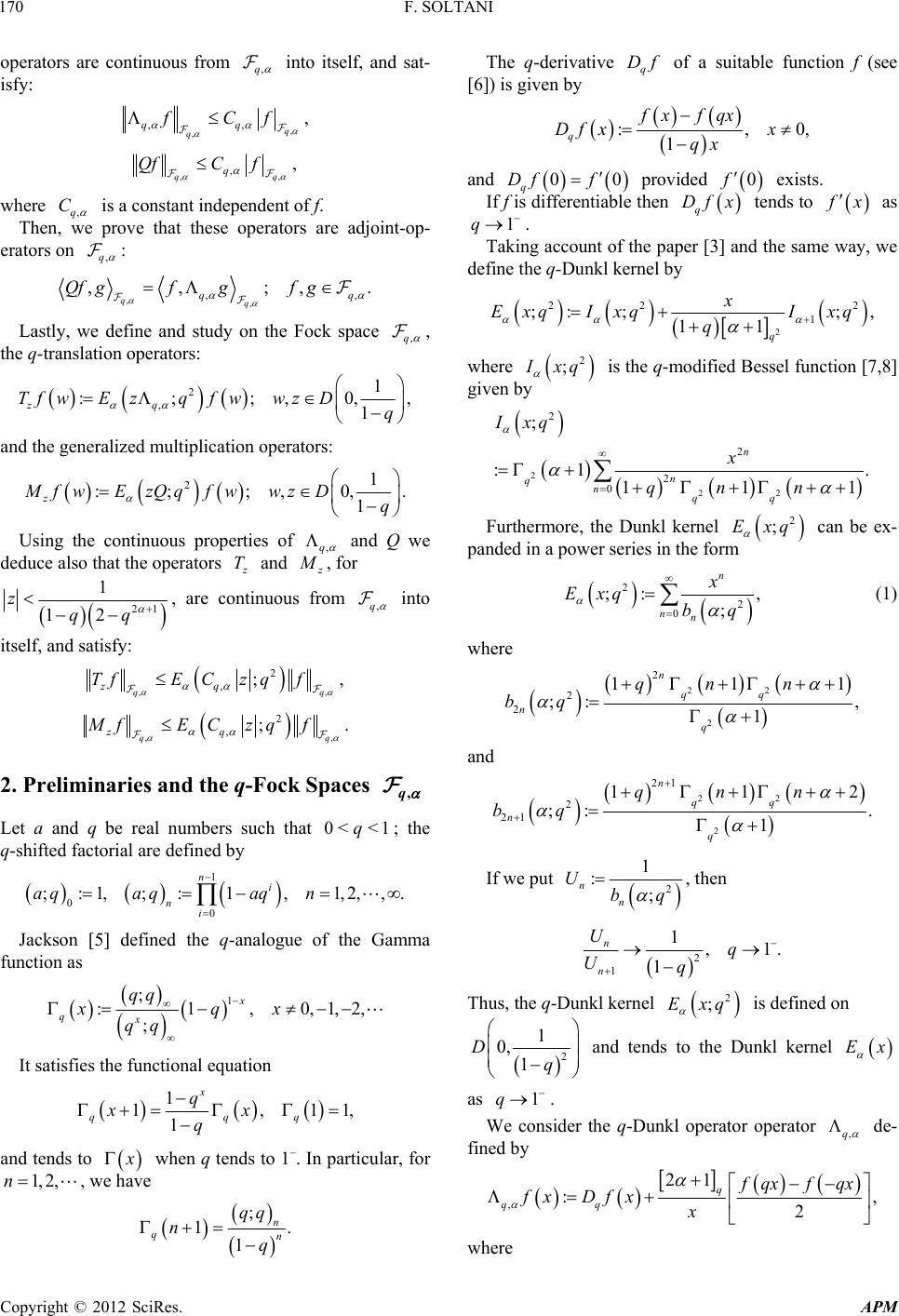 F. SOLTANI 170 operators are continuous from ,q into itself, and sat- isfy: , ,, , q qq fCf ,q ,, ,, qq q C f C Qf where ,q is a constant independent of f. Then, we prove that these operators are adjoint-op- erators on ,q : ,, ,, qq Qf gfg ,, ;,. qq f g ,q Lastly, we define and study on the Fock space , the q-translation operators: 2 , :; ; zq Tf wEzqf wwz 1 ,0,, 1 Dq and the generalized multiplication operators: 2 :; ; z MfwE zQqfwwz 1 ,0,. 1 Dq q Using the continuous properties of , and Q we deduce also that the operators T and , for 21 1 12qq ,q z, are continuous from into itself, and satisfy: ,, 2 ;, qq z qf ,zq TfE C ,, 2 ;. qq zq f , q ,zq MfE C 2. Preliminaries and the q-Fock Spaces Let a and q be real numbers such that ; the q-shifted factorial are defined by 0< <1q 11,2,,. n n 00 ;:1, ;:1, i n i a qaqaq Jackson [5] defined the q-analogue of the Gamma function as 1 ; :1 ; x qx qq xq qq ,0,1,2,x It satisfies the functional equation 1 1 qq q xx q 1, 11, x q and tends to 2, when q tends to 1–. In particular, for , we have 1,n ; 1. 1 n n qq q q Df qn The q-derivative of a suitable function f (see [6]) is given by :,0, 1 q fx fqx Df xx qx 00Df f 0f q Df x and q provided exists. If f is differentiable then tends to x as 1q . Taking account of the pap er [3] and the same way, we define the q-Dunkl kernel by 2 22 2 1 ;: ;;, 11 q x ExqIxqI xq q 2 ; where xq is the q-modif ied Bessel function [7,8] given by 2 22 2 2 2 0 ; :1 . 111 n n qnqq Ixq x qn n 2 ;Exq Furthermore, the Dunkl kernel can be ex- panded in a power series in the form 2 2 0 ;: , ; n nn x Exq bq (1) where 22 2 2 2 2 111 ;: , 1 n qq n q qn n bq and 22 2 21 2 21 112 ;: . 1 n qq n q qnn bq If we put 2 1 :; n n Ubq , then 2 1 1,1. 1 n n Uq Uq 2 ;Exq Thus, the q-Dunkl kernel is defined on 2 1 0, 1 D q and tends to the Dunkl kernel Ex 1q as ,q . We consider the q-Dunkl operator operator de- fined by , 21 :, 2 q qq qxf qx fx Dfxx where Copyright © 2012 SciRes. APM 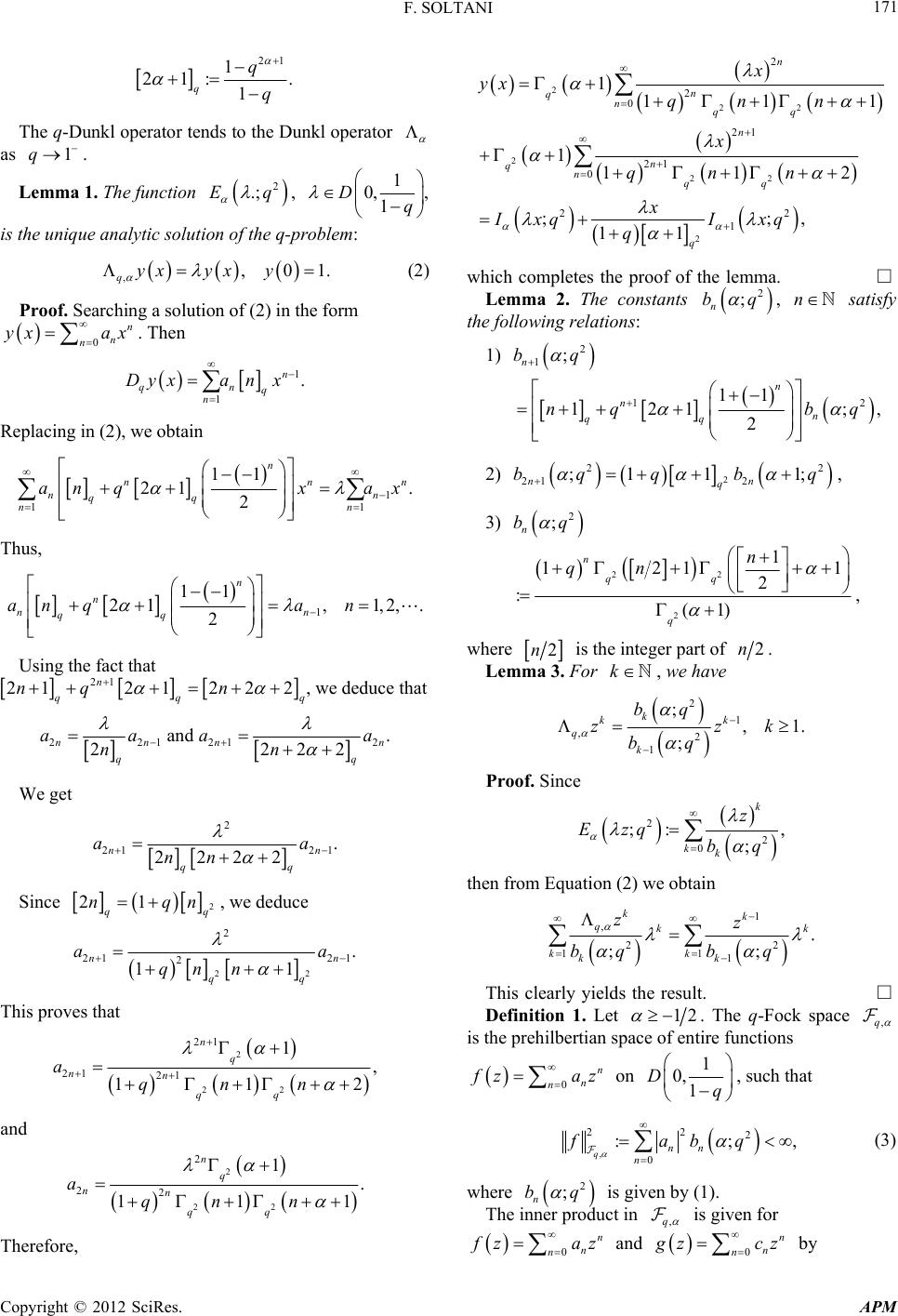 F. SOLTANI 171 21 1 : . 1 q q 21 q The q-Dunkl op erator tends to the Dunkl oper ator as . 1q Lemma 1. The function 2 .;Eq , 1 0,1 Dq , is the unique analytic solution of the q-problem: ,qyx yx ,01.y 0 n n nax 1 1. n qn q a nx (2) Proof. Searching a solution of (2) in the form . Then yx n Dy x Replacing in (2), we obtain 1 11 . n n nn nn ax 11 21 2 n n qq an qx Thus, 1 11 21 2 n n nn qq an qa , 1,2,.n Using the fact that 21 21 21 n qq nq 22 2 q n , we deduce that 22121 and 22 nnn aaa nn 2 . 22 n qq a We get 2 21 22nn 21 . 22 nn qq aa Since 2 21 qq nqn , we deduce 22 21 . 11 nn qq aa 2 21 2 qn n This proves that 2 22 21 21 21 11 n q nn qq a qn 1, 2 n and 2 2 22 22 1 111 n q nn qq a qn n . Therefore, 2 22 2 22 2 2 2 0 21 21 0 22 1 1111 1112 ;;, 11 n n qnqq n n qnqq q x yx qn n x qnn x IxqI xq q 2 ; n bq n which completes the proof of the lemma. □ Lemma 2. The constants , satisfy the following relations: 2 1; n bq 1) 12 11 121 ;, 2 n n n qq nq bq 2 22 21 2 ;1 11; nn q bq qb q , 2) 2 ; n bq 3) 22 2 1 121 1 2 :(1) n qq q n qn , where 2n is the integer part of 2n k . Lemma 3. For , we have 2 1 ,2 1 ;,1. ; k kk q k bq zzk bq Proof. Since 2 2 0 ;: , ; k kk z Ezq bq then from Equat ion (2 ) we ob tai n 1 , 22 11 1 . ;; kk qkk kk kk zz bqb q This clearly yields the result. □ Definition 1. Let 12 ,q . The q-Fock space 0 n n n is the prehilbertian space of entire functions zaz on 1 0,1 Dq , such that , 2 22 0 :;, qnn n fabq (3) 2 ;bq ,q where n The inner product in is given by (1). is given for 0 n n n zaz 0 n n n zcz by and Copyright © 2012 SciRes. APM 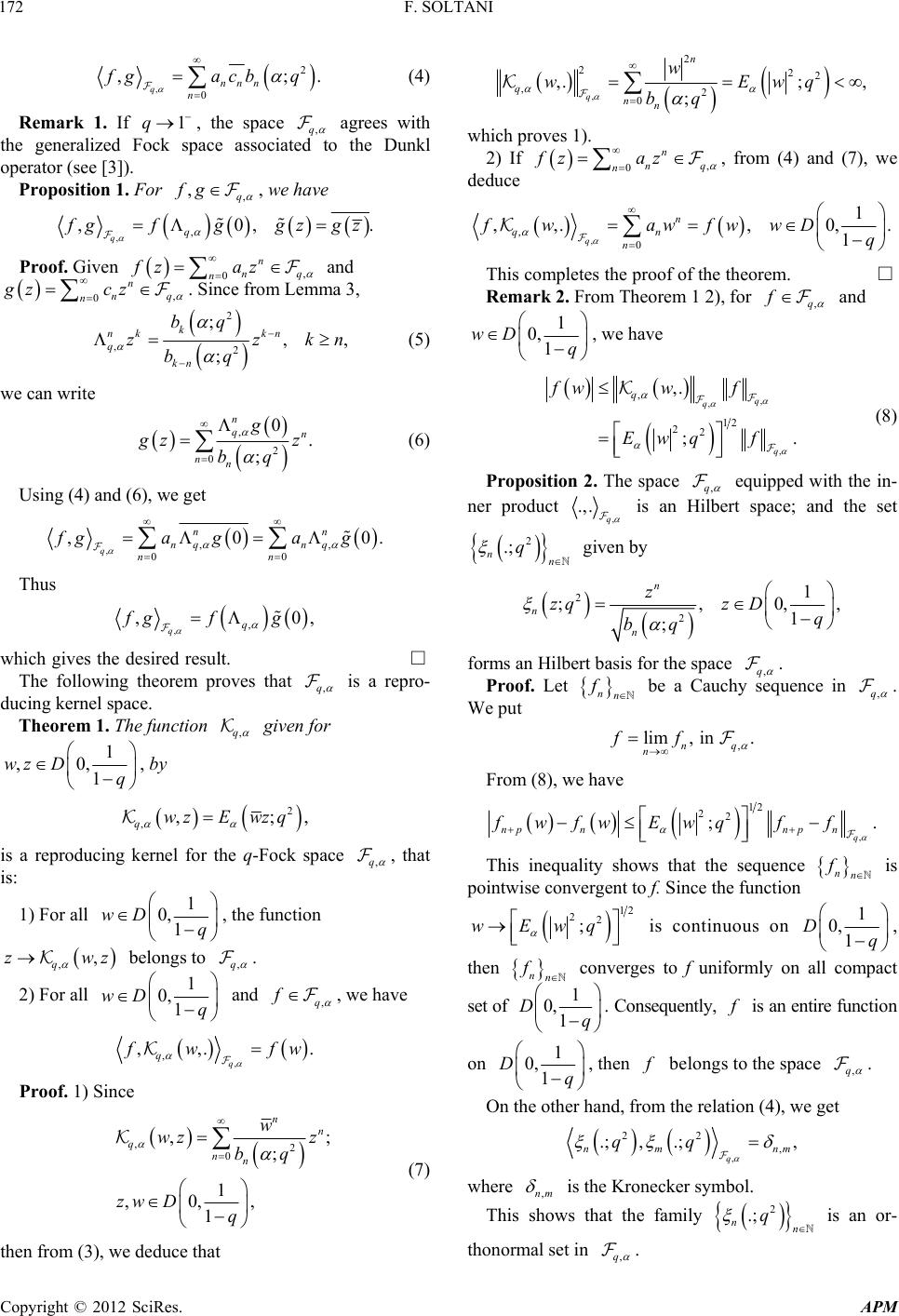 F. SOLTANI 172 2 ,;. nnn ,0 qn ga cbq 1q (4) Remark 1. If , the space ,q , ,q fg agrees with the generalized Fock space associated to the Dunkl operator (see [ 3]). Proposition 1. For , we have ,, ,0 qq,. gfg gzgz n az Proof. Given , 0nq n fz , 0 n nq n gz cz and . Since from Lemma 3, 2 ,2 ;bq ,, ; k nk kn q kn zz kn bq (5) we can write , 2 0 ; n qn nn g 0. zz bq (6) Using (4) and (6), we get ,, 0. nn nq a g ,00 ,0 qnq nn fga g Thus , ,0, qg ,q ,q fgf which gives the desired result. □ The following theorem proves that is a repro- ducing kernel space. Theorem 1. The function ,q given for 1 ,0, 1 Dq wz , by 2 ,;,E wzq ,q , qwz is a reproducing kernel for the q-Fock space , that is: 1) For all 1 0,1 wD q ,q ,q ,zw , the function z belongs to . 2) For all 1 wD ,q f 0,1q and , we have , . . q , ,, q wfw Proof. 1) Since ,0 1 ,0 , 1 q n wz zw Dq 2 ,; ; , n n n wz bq then from (3), we deduce that (7) , 22 ,2 0 ,.; , ; q q nn wE wq bq 2 2n w which p roves 1) . , 0 n nq naz 2) If fz , from (4) and (7), we deduce , ,0 1 ., 0,. 1 q n qn n awfwwDq This completes the proof of the theorem. □ ,,fw Remark 2. From Theorem 1 2), for ,q f and 1 0,D , we have 1 wq , , , , 12 22 ,. ;. q q q q fww f Ewq f (8) Proposition 2. The space ,q equipped with the in- ner product , .,.q is an Hilbert space; and the set 2 .;q nn given by 2 2 1 ;,0,, 1 ; n n zq z Dq bq forms an Hilbert basis for the space ,q n z . Proof. Let nn f be a Cauchy sequence in ,q . , lim, in. nq n ff We put From (8), we have , 12 22 ;. q npnnpn Ewqf f This inequality shows that the sequence fwfw nn f is pointwise convergent to f. Since the function 12 22 ;wEwq is continuous on 1 0,1q , then D nn f convergall compac es to f uniformly on t set of1 . Consequently, 0,1 Dq is an entire funct io n on 1 0,1 Dq , then belongs to the space ,q . n the other omt Ohand, fr the relation (4), we ge ,q where ,nm 22 , .; , .;, nm nm qq is the Kronecker symbol. sho n is an or- thonormal set in ,q This ws that the family 2 .; nq . Copyright © 2012 SciRes. APM  F. SOLTANI 173 Let 0 n n n zaz be an,q element of such that ,0, . q n 2 ,.; n fq From the relation (4), we deduce that 0, .an □ Remark 3. n T his completes the proof. 1) The set 2 .; ,1 0,Ewq wD nse in 1q is de,q . 2) For all 1 ,0, 1 Dq , we have zw , 222 ;.; . q zq Ezq 3. Operators on the Fock Spaces , q ,.;Ew Ewq On ,q , we consider the mcation operators Q and ultipli q N given by :,Qfzzf z :. qq 1 zfqz Nf zzDf zq We den also by ,q ote the q-Dunkl o peratoefined for enti r d re functions on1 0,D . ,,, 1q We write ,. q Q qq Q Q culation we obtain. ,,qqq QBW ightforward calThen by stra Lemma 4. , , wher e :, q Bfzf qz q ,:1 1. 2 q qqq WqBB Remark 4. The Lemma 4 is the analogous commuta- tion rule of [3]. When 1q 21 , then ,, qQ tends to 21 B, whe re tity operator and B is hI is the iden te parity operator given by :Bf zfz . Lemma 5. If ,q f q Bf, qd ,q Wf ,q thenNf an belong to , and 1) ,q q ,,qq q BffB f , 2) , 1q f q ,q q Nf 1 3) , , 21 q qf , ,q q Wf Proof. Let fz . , 0 n nq az n , then 0, nn qn n Bfzfqzqz a 0, 1 n qn n fz fqz Nf zanz q and from (3), we obtain q ,0 qn , 2222 22 2 0 ; ;, q n qnn nn n Bfaqbq ab qf and , 2 222 0;. q qnn q n Nfan bq Using the fact that 1 1 q nq , we deduce , 222 0 11 . q n a bf On the other hand from 1) we deduce that , 2 22 ; 11 q qn n Nf q qq , ,, , , 11 2 21 , q qq q q qq q Wf qBfqBf f 21 q which completes the proof of the Lemma. □ We now study the continuous proper ty of the oper ators ,q and Q on ,q . Theorem 2. If ,q f then ,q and Qf belong to ,q , and we have 1) , ,q q ,,qq fCf 2) , , , q q QfCf ,q , where 12 ,1 :21 . q C Proof. Let , 0 n nq n fz az 1 qq . 1) From Lemma 3, 2 1 ,11 2 1 12 0 ; ; ;. ; nn qn nn nn n nn bq 2 za z bq bq az bq (9) Then from (9), we get 2 21 22 ,1 1 2 ;;. ; n qn n n bq ,0 qn abq bq Using Lemma 2 1), we obtain Copyright © 2012 SciRes. APM  F. SOLTANI 174 , 2 , 2 0;. 2 q q n n n f bq (10) Using t 211 21 n n qq an q he fact that 1 1 q nq , we obtain , , 2 ,, 0 ,. q q qq n q fC Cf 12 2 ; nn abq 2) On the other hand, since 1 1 , n n n a z (11) th Qf z en 0;. nn a bq , 22 222 11 =1 = =;= qnn nn Qfa bq emma 2 1), we deduce By L , 2 2 11 ;. 2 q n n q Qf bq (12) Using t 21 012 1 n n q n an q he fact that 1 11 q nq , we obtain ,, ,. qq q C f following norm If ,q f Qf □ We deduce also the equalities. Theorem 3. then 1) ,,qq 2 ,, qq ffNf , ,, 2q qq B f 21 qfB 2) ,, 2, qq q Qff N f , 2 q q B f ,q qq B f 21 , 2 q q fB , 3) ,, 2 qq q QffB f ,, 2 2 ,, , qq qq f Wf . , 0nq az Proof. Let n n fz . rom (10), we get 1) F , ,, 2 , 2 11 21 ; 2 21 ,,. 2 q qq q n n n qq q qqq f nq bq fNffBBf 2) On the other hand, by (12) and using the fact t 2 n a 0n hat 1n qq nnq, we ob tain , ,, , 22 222 00 2 ;; 21 , 21 ,. 2 q qq q n nn nn q nn qq q qq Qfanbq aqbq q fNfB f q fB Bf 3) Follows directly from 1) and 2). □ Proposition 3. The operators Q and ,q 22 011; 2 n qn nn n aq b q are ad- joint-operators on ,q ; and for all , ,q fg , we have ,, qq , ,,. q Qf gfg Proof. Consider 0 n n n zaz and 0 n n n zcz in,q ), . From (9) and (11 2 1 ,1 2 0 ;, ; n qn nn bq n zc z bq an 1 1 . n n n Qf zaz Thus from (4), we get d , , 2 1 1 2 11 , ,; ;, , q q nnn n nn nq gacbq ac bqfg which gives the result. □ In the next part of this section we study a generalized translation and multiplication operators on ,q 0n Qf . We begin by the following defi nition. Definition 2. For ,q f and 1 ,0,wz D 1q we define: , The q-translation operators on ,q , by Copyright © 2012 SciRes. APM 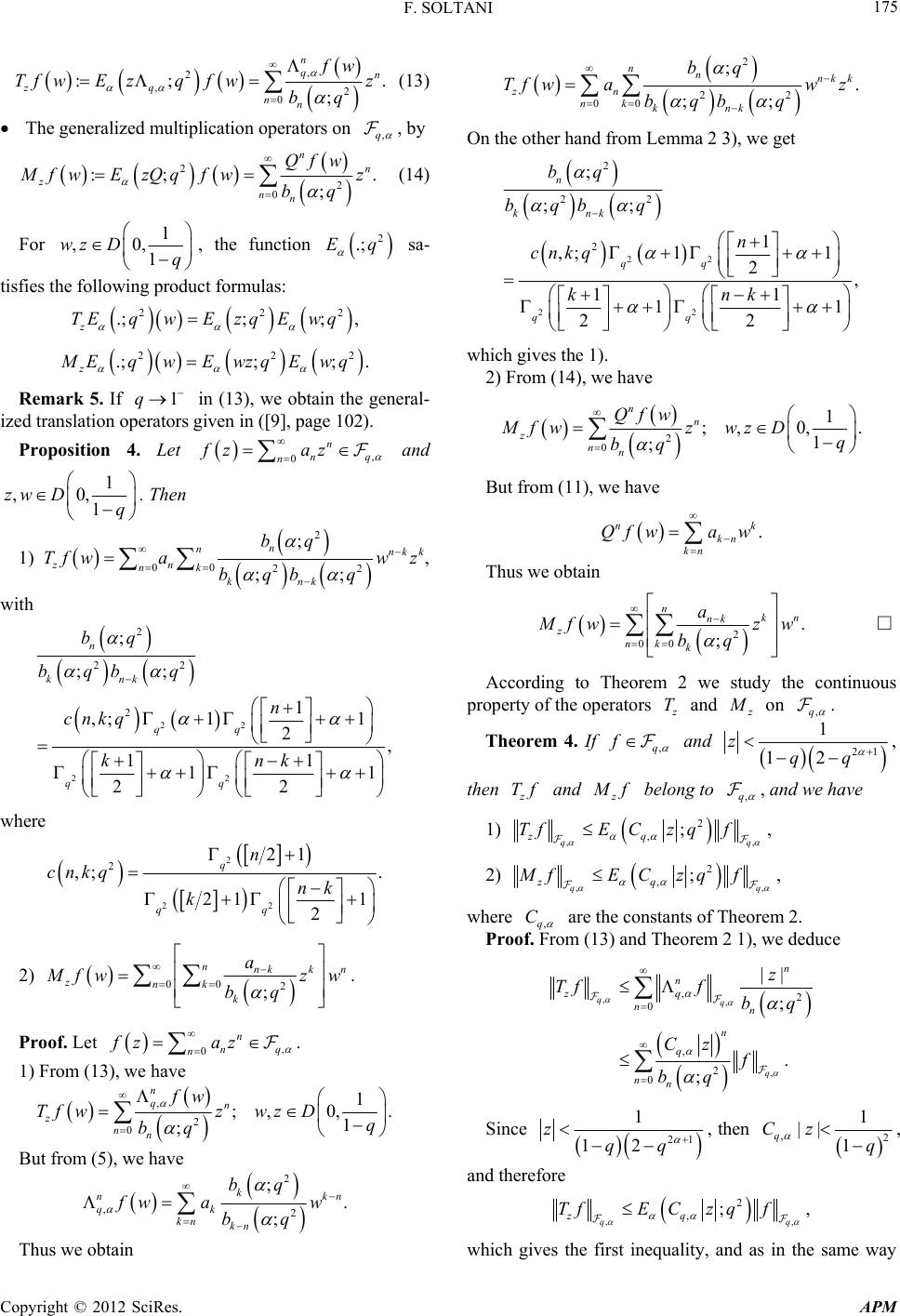 F. SOLTANI 175 , 2 ,2 0 :; ; n qn zq n fw Tf wEzqf wbq (13) . n z The generalized m ultiplication operators on ,q , by 2 02. ; n n Qfw :; z nn fw E zQqfwz bq (14) For 1 ,0, 1 Dq 2 .;Eq product wz tisfies the following , the function formulas: sa- 222 .;;; ,TEqwEzqE wq z 22 ; . 2 .; ; z EqwEwz Remark 5. If 1q in (13), qEwq we obtain the general- slation operators 102). , n nq az ized trangiven in ([9], page Proposition 4. Let 0n fz and 1 , 1 ,0 Dq . Then zw 1) 2 ; n nnkk n n bq Tf waz , 00 22 ;; zk kn k bq b q with w 22 22 2 ; n bq q 22 2 ;; 1 ,; 1 1 2, 11 11 22 kn k qq qq bq b n cnkq knk where 2 22 2 ,; 21 q qq n cnkq k 21 . 1 2 nk 2) 00 n znk k a 2 ; kn nk fw Proof. Let n z w bq . , 0nq az n fz . 1) From (13), we have , 2 0;, ; 1 0,. 1 qn z nn fw Tf wzwzDq bq from (5) , we ha ve n But 2 ;. ; k nkn kn kn bq fw aw bq ,2 qk Thus we obtain 2 22 00 ;. ;; nnnkk zn nk knk bq Tf wawz bqb q Oemma 2 3), we get n the other hand from L 22 2 22 2 ; 1 ,; 11 2, 11 1 n qq bq q n cnkq knk which gives the 1). 2) From (14), we have 22 1 22 qq ;; kn k bq b 2 0 1 ;, 0, 1 ; n n z nn Qfw Mfwzwz Dq bq But from (11), we have . kn kn f waw . nk Q Thus we obtain 2 00 . ; nkn nk z nk k a fwz w bq □ According to Theorem 2 we study the continuous property of the operators T and on ,q . ,q Theorem 4. If f and 21 1 12 zqq , then z Tf and zf belong to ,q , and we ha 1) ve ,, 2 ,; qq zq TfECz qf , 2) ,, 2 ,; qq zq MfE Czqf , where ,q C are thnts of Te constaheorem 2. Proof. From (13) and Theorem 2 1), we deduce ,, , ,2 0 , 2 ; qq q zq nn n q Tf fbq Cz f bq 0nn || n nz ; . Since 21 12qq 1 z, then ,2 1 1 qq , and therefore ||Cz ,, 2 ,;, qq zq TfECz qf which gives the first inequality, and as in the same way Copyright © 2012 SciRes. APM  F. SOLTANI Copyright © 2012 SciRes. APM 176 we prove the second inequality of this tm. □ From Proposition 3 we deduce the following results. Proposit , ,q fg heore ion 5. For all , we hav e ,, ,,, qq zz fTg Mfg ,, ,,. qq zz f Mg note by Tf g We de R the folloerator defined onwing op ,q by 22 , ;; . q Ez QqEzq Then, we prove the following theorem. 22 , :;; zzz zzq RTMMTEz qEzq ,q Q Theorem 5. For all f , we have ,, 22 qq , ,. zz z Mf TffRf Proof. From Proposition 5, we get q ,, , 2 qq q zzz zzz ,, 2,, ,. qq zz MffTMff MTRf TffRf □ REFERENCES [1] ators on of the Ameri- ciety, Vol. 1987, pp. 813- 829. doi:10.1090/S0002-9947-1987-0882716-4 C. A. Berger and L. A. Coburn, “Toeplitz Oper the Segal-Bargmann Space,” Transactions can Mathematical So 301, No. 2, [2] V. Bargmann,ytic Functions “On a Hilbert Space of Anal and an Associated Integral Transform, Part I,” Commu- nications on Pure and Applied Mathematics, Vol. 14, No. 3, 1961, pp. 187-214. doi:10.1002/cpa.3160140303 [3] M. Sifi and F. Soltani, “Generalized Fock Spaces and Weyl Relations for the Dunkl Kernel on the Real Line,” Journal of Mathematical Analysis and Applications, Vol. 270, No. 1, 2002, pp. 92-106. doi:10.1016/S0022-247X(02)00052-5 F. M. Cholewinski, “Generalized Fock Spaces and [4] Asso- ciated Operators,” SIAM Journal of Mathematical Analy- sis, Vol. 15, No. 1, 1984, pp. 177-202. doi:10.1137/0515015 [5] G. H. Jackson, “On a q-Definite Integra Journal of Pure and Applied Mathema ls,” The Quarterly ns, Vol. 14, 1997, tics, Vol. 41, No. 2, 1910, pp. 193-203. [6] T. H. Koornwinder, “Special Functions and q-Commuting Variables,” Fields Institute Communicatio pp. 131-166. [7] A. Fitouhi, M. M. Hamza and F. Bouzeffour, “The q-jα Bessel Function,” Journal of Approximation Theory, Vol. 115, No. 1, 2002, pp. 144-166. doi:10.1006/jath.2001.3645 [8] F. Soltani, “Multiplication and Translation Operators on the Fock Spaces for the q-Modified Bessel Function,” The Advances in Pure Mathematics (APM), Vol. 1, No. 2, 2011, pp. 221-227. doi:10.4236/apm.2011.14039 [9] J. J. Betancor, M. Sifi and K. Trimèche, “Hypercyclic and Chaotic Convolution Operators Associated with the Dunkl Operator on ,” Acta Mathematica Hungarica, Vol. 106, No. 1-2, 2005, pp. 101-116. doi:10.1007/s10474-005-0009-1
|